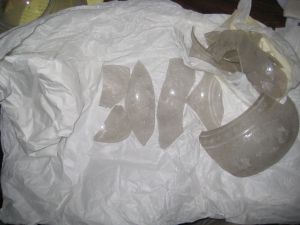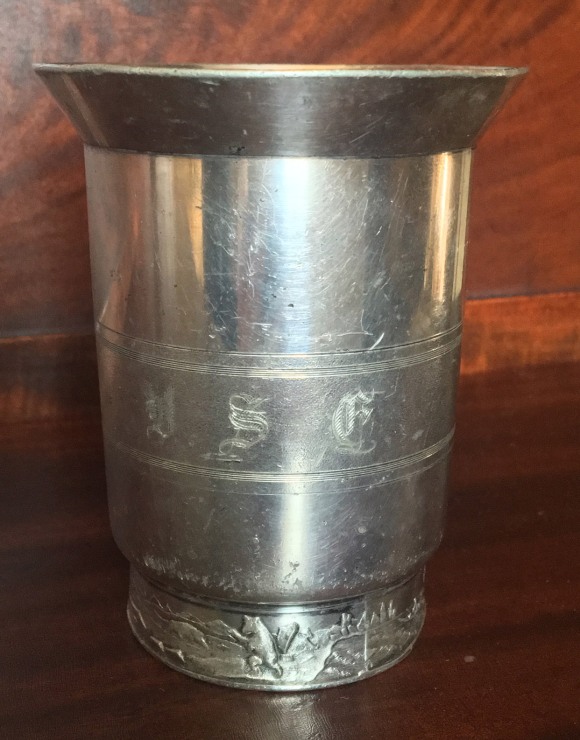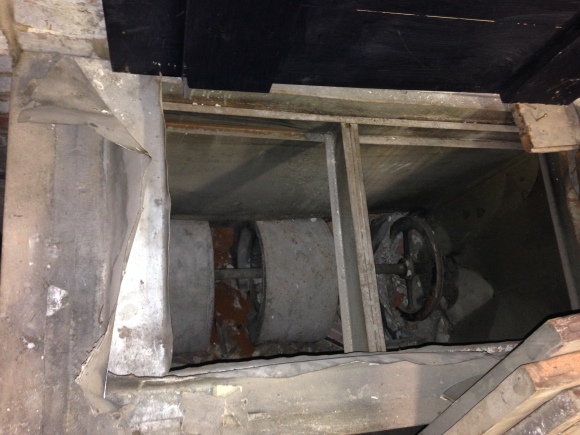Way, way back at the beginning of this blog, we covered the process of accessioning, or bringing objects into the museum’s collection. Recently, while doing some research for ongoing accessioning here at the museum, we came across our humble little blog post on the second page of a Google search for “museum accession.” This shows us two things: 1. That we’re awesome, and 2. That museums do a poor job talking about how museums function. To this end, we’ve decided to revisit the accessioning because the task is never done.
We’re always accessioning things here at the Campbell House, whether they are objects returned to the house (as with these goblets that were the subject of our first post about accessioning) or they are objects related to our mission, such as the items from our recent Lucas Place exhibit. Sometimes, we also find that we have objects in our collection that, for one reason or another, we overlooked. That’s what we did recently with our lamp globes.

Gravity+Globe=Bad News. This globe was broken more than 25 years ago.
Why were the globes never accessioned? Well, it’s probably because the lamps and gasoliers were. We simply assumed that would suffice. However, as we noted with the chimney pots, objects within the museum tend to move around a lot. Glass and gravity do not play well together either, with the result that they sometimes break. Since the globes can move around separately (and have), and since many of them are the Campbell’s originals and quite valuable in their own right, we’ve chosen to start accessioning each and every one (there are more than 100!).
To accession a globe, first we need to assign it an accession number. This number has three elements: first the year (2015), then the month (12), then a sequential number based on how many objects we’ve already accessioned that month (say, 3). That makes this globe 2015.12.3. This number has to be written on the object, or we could lose track of it. However, we can’t just write on the globe with a Sharpie, because they don’t make a museum-quality pen. We also have to protect the globe.
First, we dab on a layer of a durable, non-yellowing and quite smelly resin called B-72. After half an hour of drying, we can use a special acid-free archival pen to write the number down (chicken scratch handwriting is helpful), then we cover it with another layer of B-72.
Now we need to plug the object into our database. We use a program called PastPerfect, which is, well, perfect for small museums. PastPerfect lets us keep track of our objects, and provides an organized (and searchable!) way to write down everything we know about the object. We can describe its physical attributes, it size, its condition, where it came from, its history, who gave it to us, how much it cost, and so on. We also take a photo of the object, mark down its location, and backup all our data, because we really don’t want to have to do all this again. PastPerfect also puts this information online for us, which is what you see when you search the collections.
This slideshow requires JavaScript.
Accessioning an object can take anywhere from five minutes to an hour, depending on how important the object is, how much we know about it, and if we need to let two layers of B-72 dry. Once we’ve done this and put the object into the museum, we’re all done! Except for the cleaning, the rearranging, the annual “eyeball” inventory, the donation forms…

 How the families became acquainted is unknown. Robert almost certainly knew Julia Grant’s father from St. Louis business circles and Julia Dent Grant and Virginia Campbell had very similar backgrounds and upbringings.
How the families became acquainted is unknown. Robert almost certainly knew Julia Grant’s father from St. Louis business circles and Julia Dent Grant and Virginia Campbell had very similar backgrounds and upbringings.

















